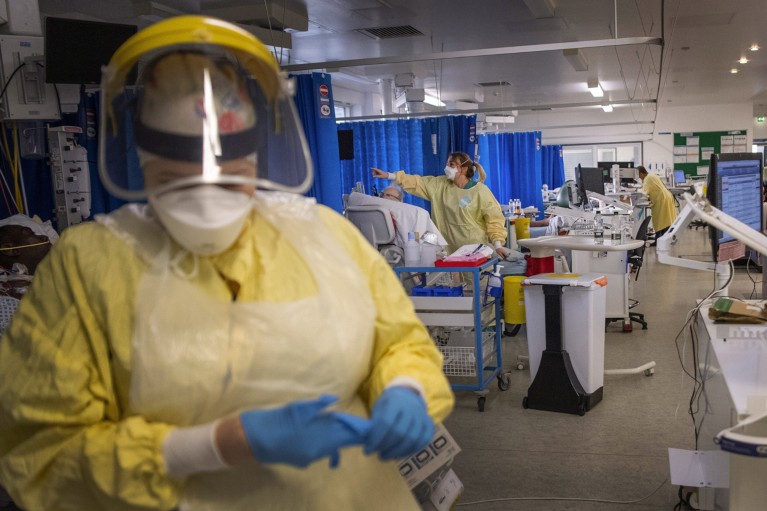
Health care, with all its complexities, is often wrongly modelled as if it were a service industry, says Alison Leary.Credit: Victoria Jones/PA/Alamy
Alison Leary’s career spans engineering, nursing and data science. In her current role as a workforce-modelling researcher at London’s South Bank University, she uses data-mining and pattern-recognition skills to model complex systems.
Leary also works for the World Health Organization, advising national agencies and governments on workforce modelling. Her work has contributed to global and national policy in various countries; in health care, she has studied more than 70 specialist workforces.
Before moving into academia, she worked for the commercial sector, doing mathematical modelling and data mining in fields including retail and pharmacy, and the aeronautical and space industries. Today, she provides that modelling expertise on a consultancy basis with a focus on complex systems, such as the United Kingdom’s National Health Service (NHS) workforce.
Leary tells Nature’s careers team about her mission to make under-recognized but crucial ‘pink collar’ work (service-oriented roles historically associated with women, such as nursing) more visible. Health care is often wrongly modelled as if it were a service industry, similar to grocery or hospitality, she argues. Instead, the focus should be on quality and safety, and on acknowledging its complexity.
Finally, she says, some lessons from health care can be applied to tackle the ‘leaky pipeline’ in academia, particularly as it affects women.
Can you describe your career so far?
After completing an apprenticeship in electrical engineering, I did a degree in natural sciences and worked in industry and the NHS as an engineer for ten years. I retrained as a registered nurse, specializing in haematology and blood cancers. After a master’s degree in biomedical science, I did a PhD in thoracic oncology at University College London.
I became concerned about how poorly understood (and, to a certain extent, invisible) the contribution of specialist nurses was, so I developed an online tool to quantify their value to hospital board executives.

Bias in science: how to fight the good fight
That was the start of my interest in interrogating workforces and examining their potential optimization. What interests me is the relationship between work, workforces and safety or outcomes. My particular focus is in modelling the demand for labour, particularly highly skilled labour, where work is complex.
The best endorsement I’ve ever received is that I “am not afraid to be unpopular”.I think this relates to my research, which tends to challenge the new and shiny ‘solutions’ that the health-care-policy world seems to favour. Health care has its own culture, which makes original evidence-based thinking a challenge to introduce or implement.
How do you model a workforce?
You collect data to build an accurate picture of the workforce, how it is structured and how it behaves. You also look at labour expenditure, as well as work done and work that is left undone, and look for points of improvement.
The basic steps are, first, understand the work and its purpose. Next, break down the work into component parts and count them. You can then start collecting data from which to build a model to explain how the workforce currently works; it will only ever be a representation of the real world. I spend a good proportion of my time understanding the work and the context in which it’s carried out, and checking any assumptions against that reality.
Finally, you can use the data to re-model the workforce to show how it might work better if adjustments were made, for example by altering workflows or the number of staff with particular qualifications. This can also reveal the risk that some work will not be done, and the consequences of that.
For example, my modelling for the inflammatory-bowel-disease specialist-nursing workforce recommended a staff-to-patient ratio of 2.5 full-time-equivalent specialist nurses per 250,000 patients. It has become the European standard.
No model is perfect, some are more useful than others, and we initially aim for roughly right, rather than precisely wrong. The models are iterative, too, so with more data over time, they refine and generate greater insights.
How can we level the professional playing field and create more opportunities for women in academia?
The structural inequality in society is reflected in scientific and academic careers. Whether it’s nursing, academia or clinical sciences, you see the scissor effect — where there are plenty of women in the lower ranks but their representation slides in higher ranks.
We lose women in science, engineering and technology (the ‘leaky pipeline’) for a number of reasons. Yes, women are more likely to take up caring responsibilities, but there are other factors, such as the authority gap — the lack of visible female leaders in the field. Plus, there’s an opportunity gap: it’s harder to access those opportunities when you are working part-time or have other responsibilities.
A lack of confidence can also be an obstacle. And factors such as ethnicity and social class have an impact: you might not have the same opportunities to network as those who hold more privilege or structural advantage.






